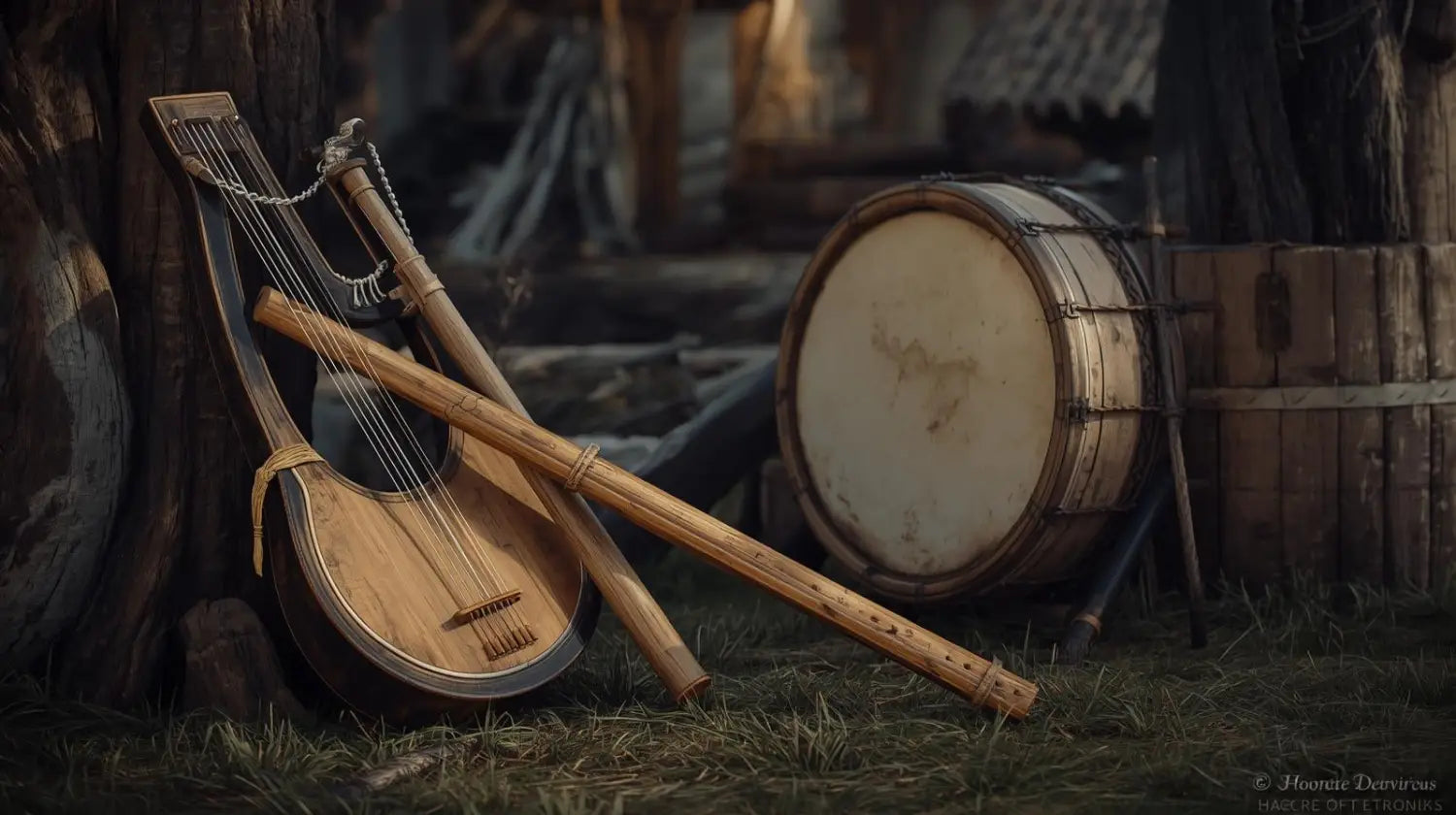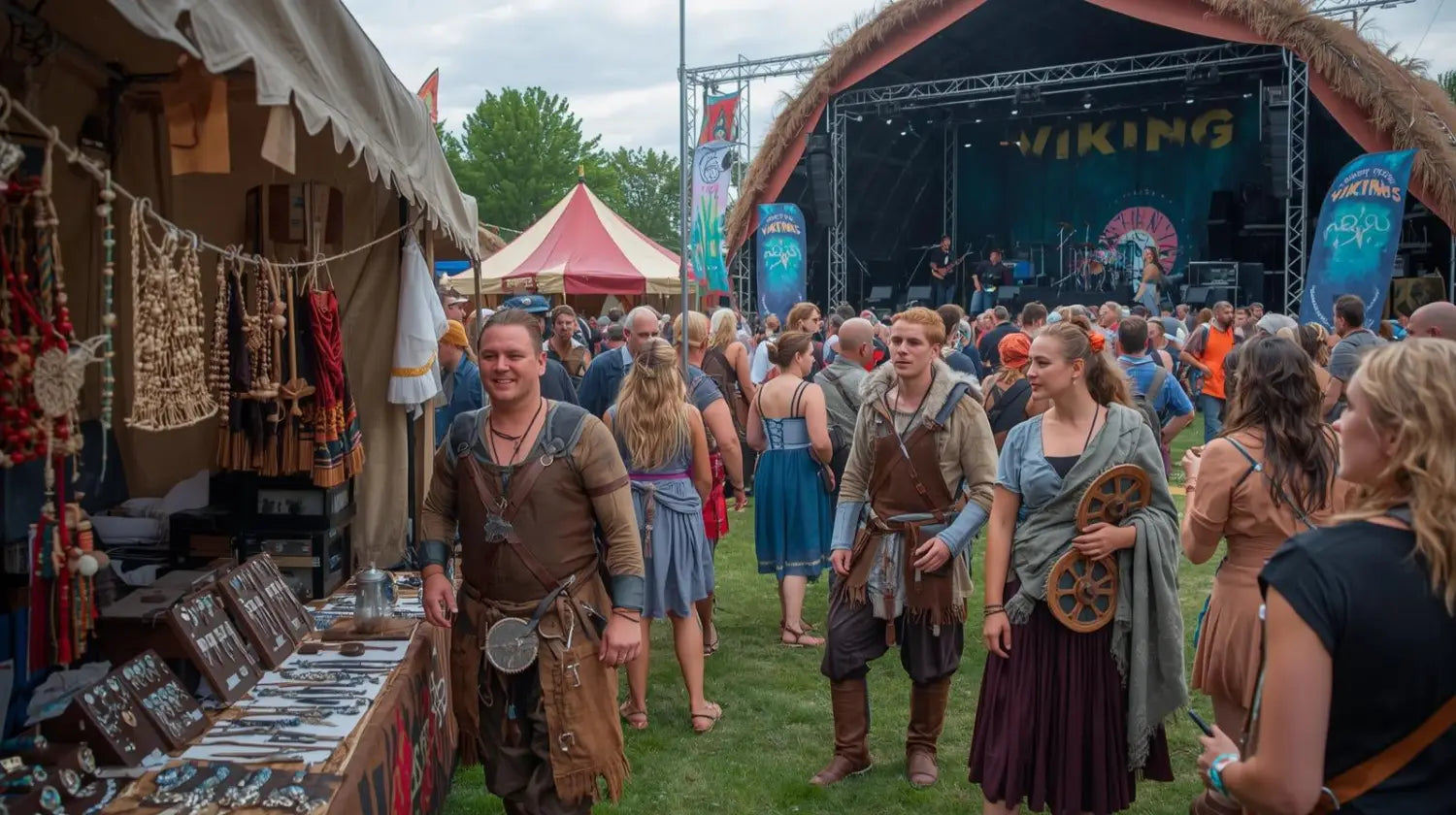Traditional and Modern “Viking” Music — Origins, Instruments, and Today’s Scene
Introduction
Music formed an essential part of everyday and ritual life in Viking Age Scandinavia, but what we think of today as “Viking music” is an amalgam of archaeology, later medieval sources, oral traditions, and modern creative revival. This article surveys the archaeology and likely sounds of traditional Viking music, the instruments attested in the record, and the modern musical movements (folk, neo-folk, “dark Nordic” and Viking metal) that draw on these roots. It also gives practical examples—bands, festivals, and listening recommendations—so you (or a modern pagan listener) can explore both historically grounded sound and contemporary interpretations.
________________________________________
What the evidence tells us about Viking-age music
Direct evidence for melodies from the Viking Age is sparse: musical notation is essentially absent and the surviving documents that mention singing or poetry post-date the Viking Age. Nevertheless, archaeology and medieval accounts provide several reliable clues. Excavations and museum research show that music was played at feasts, ceremonies and on daily occasions; finds include bone and wooden flutes, fragments of lyres, and metal lurs (long trumpet-like instruments). These finds, together with later Scandinavian folk practice, allow scholars to reconstruct a plausible sound-world of pitched string timbres, simple flutes, trumpet calls and drums used in social and ritual contexts.
Key archaeological examples include small bone recorders and multi-holed flutes uncovered at trading sites such as Birka and Ribe, and the much-publicized discovery of the Ribe Lyre (dated to around the 8th century), which demonstrates that plucked string instruments were in use in the region well before or during the Viking Age. The lur—often found in paired bronze examples from earlier and contiguous Scandinavian contexts—suggests a long tradition of loud signalling or ceremonial trumpet sounds.
________________________________________

Typical Viking-age instruments (what actually exists in the record)
Below are the principal instrument types attested or strongly inferred from finds and ethnographic parallels:
Lyres / plucked strings: Wooden lyre fragments or iconographic parallels (e.g., the Ribe Lyre) indicate plucked, harp-like instruments used for accompaniment of songs and recited poetry.
Bone and wooden flutes / recorders: Small wind instruments with one to several finger holes; likely used for simple melodies and dance tunes.
Lur (long horn): A loud, conical horn possibly used for signalling, gatherings, and ritual. Examples in museums show construction details and possible ceremonial use.
Frame drums and skin-drums: While fewer durable examples survive, ethnographic parallels and later sources suggest rhythmic membranophones were used in ritual and communal music-making.
Bowed/horsehair fiddles (tagelharpa / jouhikko family): Evidence is mixed and largely later, but related bowed fiddles appear in Northern Europe and may have antecedents or continuities in Scandinavian practice.
Because melodies are rarely preserved, scholars reconstruct likely musical contexts from verse forms (for example, skaldic and Eddic metre), where repetitive rhythms and alliteration imply sung or chanted performance, often with instrumental accompaniment.
________________________________________
What would a historical pagan Viking likely have heard and enjoyed?
A Viking pagan attending a feast or ritual probably experienced a combination of: recited and chanted poetry (skaldic verse), short flute or lyre melodies that supported the voice, loud lur or horn signals (for assemblies or ceremonial moments), and rhythmic drumming for dances or trance-like rituals. Vocal performance—narrative, alliterative and metrically strict—was central. The emphasis was on communal participation, memory (oral preservation of genealogies and heroic tales), and the blending of sound and ritual action.
________________________________________
The modern revival: genres, artists, and how they connect to the past
Modern “Viking” music is a spectrum that ranges from academically informed reconstructions to theatrical, ritual, or metal-based reinterpretations. Several distinct strands have emerged:
Nordic folk / historical reconstruction: Groups that use reconstructed or traditional instruments and aim for historically plausible soundscapes. They often collaborate with museums or archaeologists and use ancient melodies where available.
Ambient / dark folk / ritual folk: Artists weave chants, frame drums, nature-sounds and historical instruments into atmospheric pieces meant to evoke pre-Christian northern spirituality. This strand emphasizes mood, ritual aesthetics, and a feeling of antiquity rather than literal historical replication.
Neofolk & Viking metal: Bands combine folk instruments and melodies with rock/metal instrumentation and lyrics inspired by Norse myths and heroic themes. This category includes both melodic and extreme metal subgenres and has been central to festivals and wider popularization.
Representative contemporary acts (examples with different approaches): Wardruna (Norway) blends traditional instruments, runic and poetic texts, and field recordings—often cited for its careful use of Nordic instruments and cultural sources. Heilung (international) presents ritualized performances drawing on Iron-Age and early medieval texts and sounds with strong theatrical elements. Danheim (Denmark) produces beat-driven dark folk with an explicit Viking aesthetic. Other notable names include Skáld, Myrkur (bridging black metal and folk) and various neo-folk and folk-metal acts across Scandinavia and Europe.
________________________________________

Festivals and where this music is heard live
If you want to hear modern Viking-inspired music live, larger European festivals increasingly program these acts alongside metal and folk artists. Two important examples:
Midgardsblot (Borre, Norway): an annual festival combining folk, black/extreme metal and historical programming at a significant Viking archaeological site—it intentionally connects music with archaeological context and living history.
JORVIK Viking Festival (York, UK): while primarily a living-history and family festival, it regularly hosts music, reenactment and evening performances that showcase historical song and modern reconstructions.
In addition to these, many folk and early-music festivals across Scandinavia and Europe present dedicated stages for Nordic folk, ritual folk, and historically informed ensembles.
________________________________________
If you’re a modern pagan (or want an authentic listening list)
A “Viking” pagan interested in music that resonates with historical and spiritual themes might enjoy a mix of approaches:
Historically rooted / acoustic: research ensembles and artists who use Lyre, lur, bone flutes and frame drums—listen for sparse arrangements and verse-driven singing. (Start with Wardruna’s earlier albums for a blend of tradition and accessible composition.)
Ritual / atmospheric: Heilung and some Danheim tracks emphasize trance rhythms, spoken runes and ritual framing—suitable for meditative or ceremonial contexts.
Folk / metal fusion: if you prefer intensity, explore “Viking metal” or folk-metal bands that interleave mythic lyrics with martial energy.
________________________________________
Conclusion — balancing history and modern meaning
The soundscape we call “Viking music” today is part archaeology, part folklore, and part contemporary imagination. Archaeological finds (bone flutes, lyre fragments, lurs) and medieval poetic forms give us solid clues about instrumentation and performance contexts, but melodies and exact styles are largely lost to time. Modern artists—whether academically inclined ensembles or atmospheric ritual groups—bridge that gap, offering new ways for listeners, reenactors and pagans to experience a northern musical aesthetic. If you seek historical accuracy, prioritize groups that collaborate with museums and scholars; if your aim is spiritual resonance, the ritual and ambient strands can provide evocative, meaningful sound. Either way, the revival demonstrates the continuing power of music to connect people with the past—and to reinvent it for the present.
Northlord Team
